2021 年广东暨南大学基础英语考研真题
招生专业与代码:050205 日语语言文学、050203 法语语言文学
考试科目名称及代码:241 基础英语
考生注意:所有答案必须写在答题纸(卷)上,写在本试题上一律不给分。
Part I
Cloze (10 points)
Directions: Thereare20blanksinthefollowingpassage.Foreachblankthereare
four choices marked A, B, C and D. You should choose the ONE that best fits into
the passage and write the corresponding letter on the Answer Sheet.
From childhood to old age, we all use language as a means of broadening our
knowledge of ourselves and the world about us. When humans first __1__, they were
like newborn children, unable to use this __2__ tool. Yet once language developed,
the possibilities for humankind’s future __3__ and cultural growth increased.
Many linguists believe that evolution is __4__ for our ability to produce
and use language. They __5__ that our highly evolved brain provides us __6__ an innate
language ability not found in lower __7__. Proponents of this innateness theory say
that our __8__ for language is inborn, but that language itself develops gradually,
__9__ a function of the growth of the brain during childhood. Therefore there are
critical __10__ times for language development.
Current __11__ of innateness theory are mixed, however, evidence supporting the
existence of some innate abilities is undeniable. __12__, more and more schools are
discovering that foreign languages are best taught in __13__ grades. Young children
often can learn several languages by being __14__ to them, while adults have a much
harder time learning another language once the __15__ of their first language have
become firmly fixed.
__16__ some aspects of language are undeniably innate, language does not
develop automatically in a vacuum. Children who have been __17__ from other human
beings do not possess language. This demonstrates that __18__ with other human beings
is necessary for proper language development. Some linguists believe that this is
even more basic to human language __19__ than any innate capacities. These theorists
�
view language as imitative, learned behavior. __20__, children learn language from
their parents by imitating them. Parents gradually shape their child’s language
skills by positively reinforcing precise imitations and negatively reinforcing
imprecise ones.
1. A.generated
B.evolved
C.born
D.originated
2. A.valuable
B.appropriate
C.convenient
D.favorite
3. A.attainments
B.feasibility
C.entertainments
D.evolution
4. A.essential
B.available
C.reliable
D.responsible
5. A.confirm
B.inform
6. A.for
B.from
C.claim
C.of
D.convince
D.with
7. A.organizations
B.organisms
C.humans
D.children
8. A.potential
B.performance
C.preference
D.passion
9. A.as
B.just as
C.like
D.unlike
10. A.ideological
B.biological
C.social
D.psychological
11. A.reviews
B.reference
C.reaction
D.recommendation
12. A.In a word
B.In a sense
C.Indeed
D.In other words
13. A.various
B.different
C.the higher
D.the lower
14. A.revealed
B.exposed
C.engaged.
D.involved
15. A.regulations
B.formations
C.rules
D.constitutions
16. A.Although
B.Whether
C.Since
D.When
17.
B.different
C.protected
D.isolated
A.distinguished.
18. A.exposition
B.comparison
C.contrast
D.interaction
19. A.acquisition
B.appreciation
C.requirement
D.alternative
20. A.As a result
B.After all
C.In other words
D.Above all
Part II
Reading Comprehension
Section A (40 points)
Directions:Thereare4passagesinthissection.Eachpassageisfollowedbysome
questionsorunfinishedstatements.Foreachofthemtherearefourchoicesmarked
�
A,B,CandD.Youshoulddecideonthebestchoiceandwritethecorrespondingletter
on the Answer Sheet.
Questions 21 to 25 are based on the following passage.
I’ve been attempting to learn French for a while now, and it’s a slow process.
It’s all much harder this time around than it was to learn English, my first language.
All this effort made me wonder if there were some tricks to learning a foreign
language that I’d been missing. It turns out that it’s just a tricky thing to do
once you’re an adult.
Learning language is something we’re born to do. It’s an instinct we have, which
is proven, as one research paper says. To believe that special biological adaptations
are a requirement, it is enough to notice that all the children but none of the dogs
and cats in the house acquire language. As children, we learn to think, learn to
communicate and intuitively pick up an understanding of grammar rules in our mother
tongue, or native language. From then on, we learn all new languages in relation
to the one we first knew — the one that we used to understand the world around us
for the first time ever.
When it comes to learning a second language, adults are at a disadvantage. One
theory of why learning a foreign language is so hard for adults focuses on the process
we go through to do so. Robert Bley-Vroman explains in LinguisticPerspectiveson
Second Language Acquisition that adults approach learning a new language with an
adult problem-solving process, rather than in the same way a child develops language
for the first time.
Although this means adults generally progress through the early stages of
learning a language faster than children, people who are exposed to a foreign
language first during childhood usually achieve a higher proficiency than those who
start out as adults.
There’s still hope, though. A study of secondary language pronunciation found
that some learners who started as adults scored as well as native speakers. It’
s also been shown that motivation to learn can improve proficiency, so if you really
�
want to learn a language, it’s not necessarily too late.
21. What did the author realize from his experience of learning French?
A. Learning French is difficult for an adult.
B. French is as difficult as English for him.
C. He has missed the tips on learning French.
D. It demands great efforts to learn a language.
22. How are we influenced by the way we learned our mother tongue?
A. We prefer to learn by understanding the grammar rules first.
B. We tend to attach more importance to listening and speaking.
C. We are inclined to learn all other new languages in relation to it.
D. We may unconsciously think it is the best way to learn languages.
23. According to Robert Bley-Vroman, how do adults approach a new language?
A. They tend to choose a problem-solving process.
B. They try to be exposed to a foreign environment.
C. They follow the way a child learns a language.
D. They start by taking language proficiency practices.
24. According to the passage, what is the good news for adult learners?
A. They can achieve a higher proficiency than most children.
B. They can speak the language as good as the native speakers.
C. They can master a foreign language once they are motivated.
D. They can improve proficiency by imitating the way kids learn.
25. What is the passage mainly about?
A. The differences between child learners and adult learners.
B. The possible difficulties language learners may come across.
C. The common ways people choose to learn a foreign language.
�
D. The disadvantages of and hopes for an adult language learner.
Questions 26 to 30 are based on the following passage.
Some pessimistic experts feel that the automobile is bound to fall into disuse.
They see a day in the not-too-distant future when all autos will be abandoned and
allowed to rust. Other authorities, however, think the auto is here to stay. They
hold that the car will remain a leading means of urban travel in the foreseeable
future.
The motorcar will undoubtedly change significantly over the next 30 years. It
should become smaller, safer, and more economical, and should not be powered by the
gasoline engine. The car of thefuture should be far more pollution-free than present
types.
Regardless of its power source, the auto in the future will still be the main
problem in urban traffic congestion. One proposed solution to this problem is the
automated highway system.
When the auto enters the highway system, a retractable (可伸缩的) arm will drop
from the auto and make contact with a rail, which is similar to those powering subway
trains electrically. Once attached to the rail, the car will become electrically
powered from the system, and control of the vehicle will pass to a central computer.
The computer will then monitor all of the car’s movements.
The driver will use a telephone to dial instructions about his destination into
the system. The computer will calculate the best route, and reserve space for the
car all the way to the correct exit from the highway. The driver will then be free
to relax and wait for the buzzer (蜂鸣器) that will warn him of his coming exit.
It is estimated that an automated highway will be able to handle 10,000 vehicles
per hour, compared with the 1,500 to 2,000 vehicles that can be carried by a
present-day highway.
26. One significant improvement in the future car will probably be ________.
A. its driving system
�
B. its power source
C. its monitoring system
D. its seating capacity
27. What is the author’s main concern?
A. How to render automobiles pollution-free.
B. How to make smaller and safer automobiles.
C. How to develop an automated subway system.
D. How to solve the problem of traffic jams.
28. What provides autos with electric power in an automated highway system?
A. A rail.
B. An engine.
C. A retractable arm.
D. A computer controller.
29. In an automated highway system, all the driver needs to do is ________.
A. keep in the right lane
B. wait to arrive at his destination
C. keep in constant touch with the computer center
D. inform the system of his destination by phone
30. What is the author’s attitude toward the future of autos?
A. Enthusiastic.
B. Optimistic.
C. Pessimistic.
D. Cautious.
Questions 31 to 35 are based on the following passage.
We all know that DNA has the ability to identify individuals but, because it
�
is inherited, there are also regions of the DNA strand which can relate an individual
to his or her family (immediate and extended), tribal group and even an entire
population. Molecular Genealogy ( 宗 谱 学 ) can use this unique identification
provided by the genetic markers to link people together into family trees.
Pedigrees(家谱) based on such genetic markers can mean a breakthrough for
family trees where information is incomplete or missing due to adoption,
illegitimacy or lack of records. There are many communities and populations which
have lost precious records due to tragic events such as the fire in the Irish courts
during Civil War in 1921 or American slaves for whom many records were never kept
in the first place.
The main objective of the Molecular Genealogy Research Group is to build a
database containing over 100,000 DNA samples from individuals all over the word.
These individuals will have provided a pedigree chart of at least four generations
and a small blood sample. Once the database has enough samples to represent the world
genetic make-up, it will eventually help in solving may issues regarding genealogies
that could not be done by relying only on traditional written records.
Theoretically, any individual will someday be able to trace his or her family
origins through this database.
In the meantime, as the database is being created, molecular genealogy can
already verify possible or suspected relationships between individuals. “ For
example, if two men sharing the same last name believe that they are related, but
no written record proves this relationship, we can verify this possibility by
collecting a sample of DNA from both and looking for common markers( in this case
we can look primarily at the Y chromosome(染色体) ,” explains Ugo Perego, a member
of the BYU Molecular Genealogy research team.
31. If two men suspected for some reason they have a common ancestor,__________.
A. we can decide according to their family tree
B. we can find the truth from their genetic markers
C. we can compare the differences in their Y chromosome
�
D. we can look for written records to prove their relationship
32. People in a large area may possess the same DNA thread because__________.
A. DNA is characteristic of a region
B. they are beyond doubt of common ancestry
C. DNA strand has the ability to identify individuals
D. their unique identification can be provided via DNA
33. Which of the following CANNOT be inferred from the passage?
A. We are a walking, living, breathing record of our ancestors.
B. Many American slaves did not know who their ancestors were.
C. An adopted child generally lacks enough information to prove his identity.
D. Molecular Genealogy can be used to prove a relationship between individuals.
34. The Molecular Genealogy Research Group is building a database for the purpose
of__________.
A. offering assistance in working out genealogy-related problems
B. solving many issues without relying on traditional written records
C. providing a pedigree chart of at least four generations in the world
D. confirming the assumption that all individuals are of the same origin
35. The possible research of family trees is based on the fact that__________.
A. genetics has achieved a breakthrough
B. genetic information contained in DNA can be revealed now
C. each individual carries a unique record of who he is and how he is related to
others
D. we can use DNA to prove how distant an individual is to a family, a group or a
population
Questions 36 to 40 are based on the following passage.
Stone tools, animal bones and an incised mammoth tusk found in Russia’s frigid
�
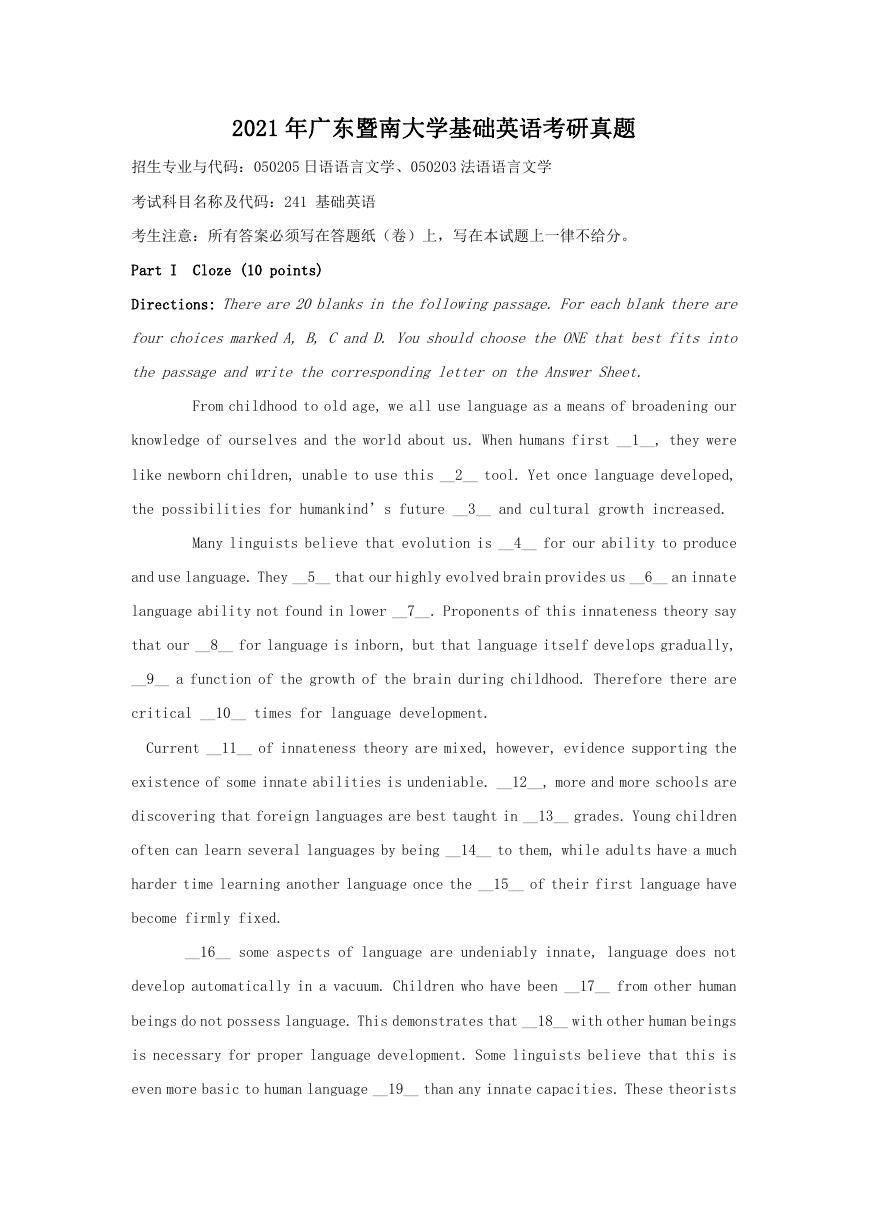


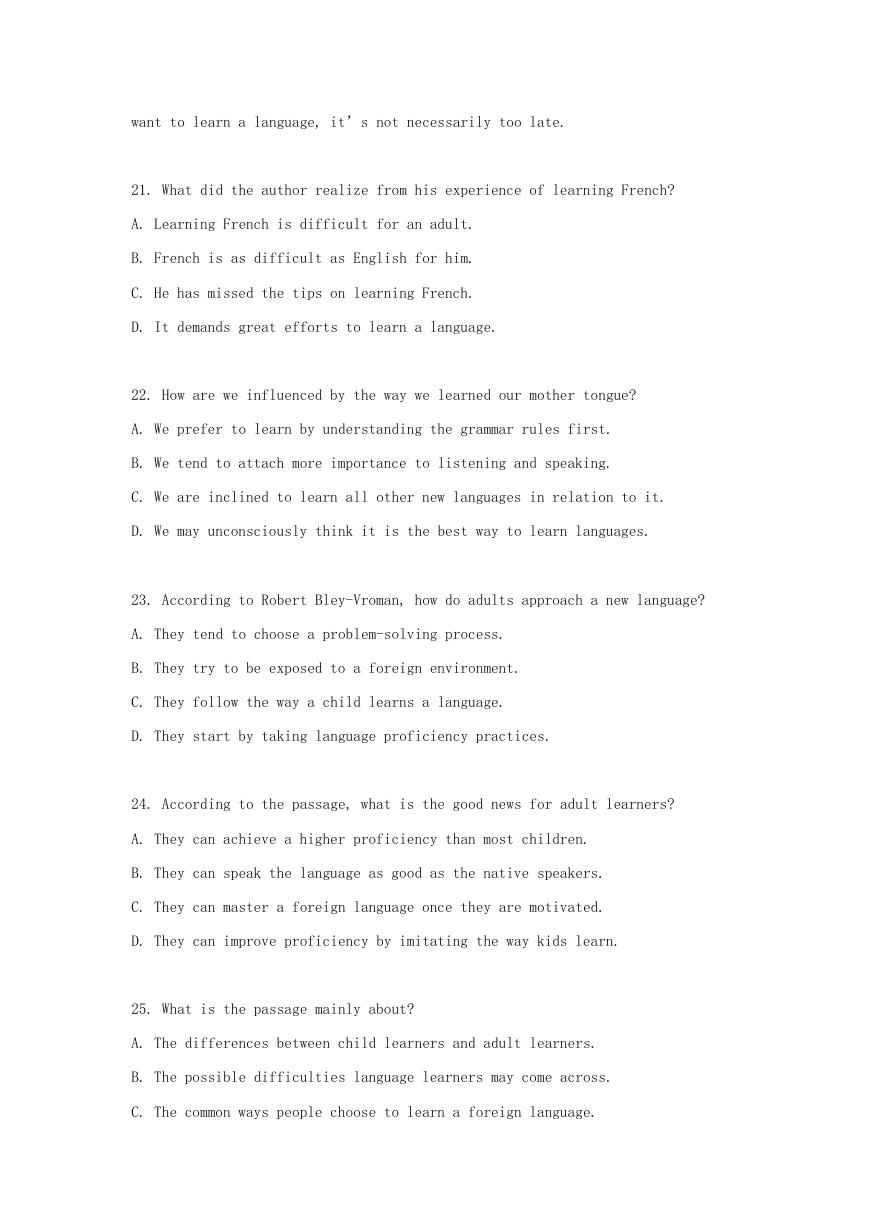
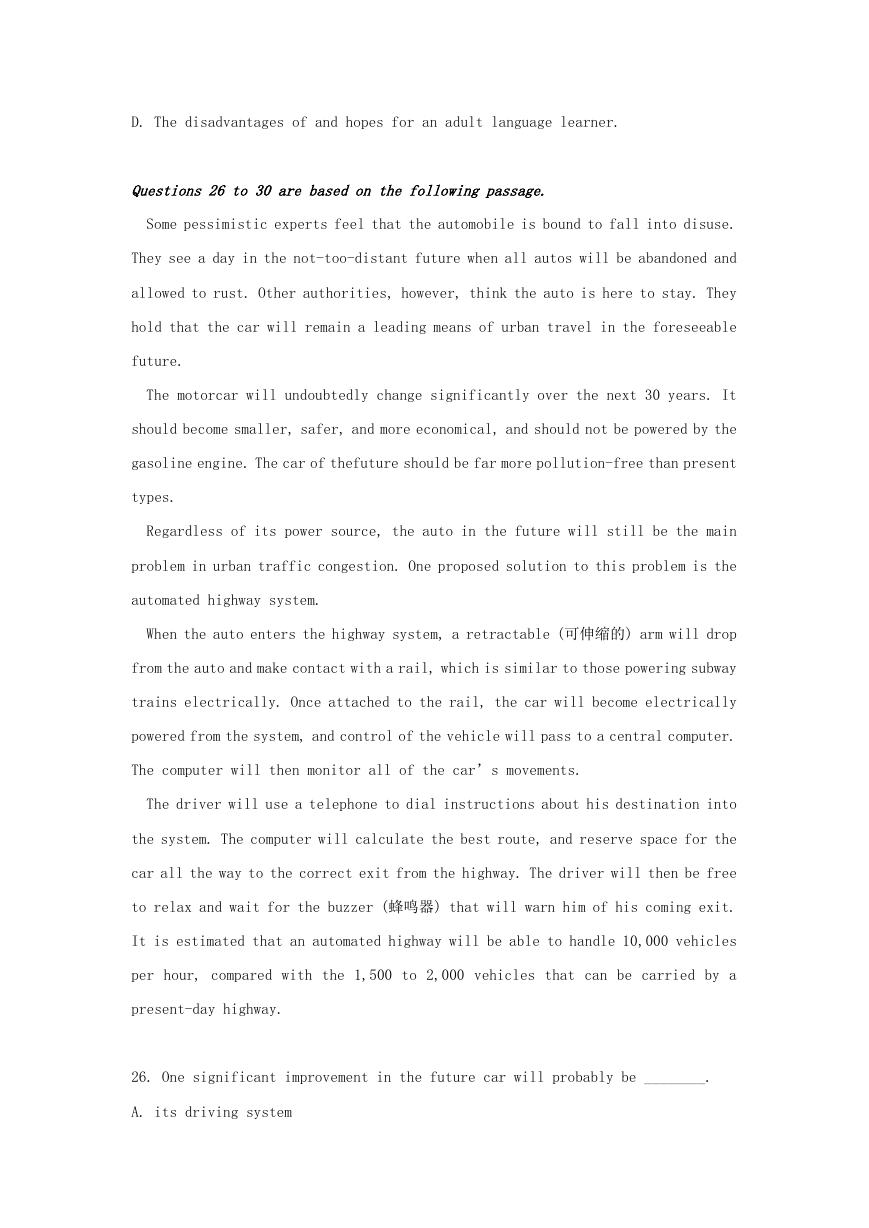
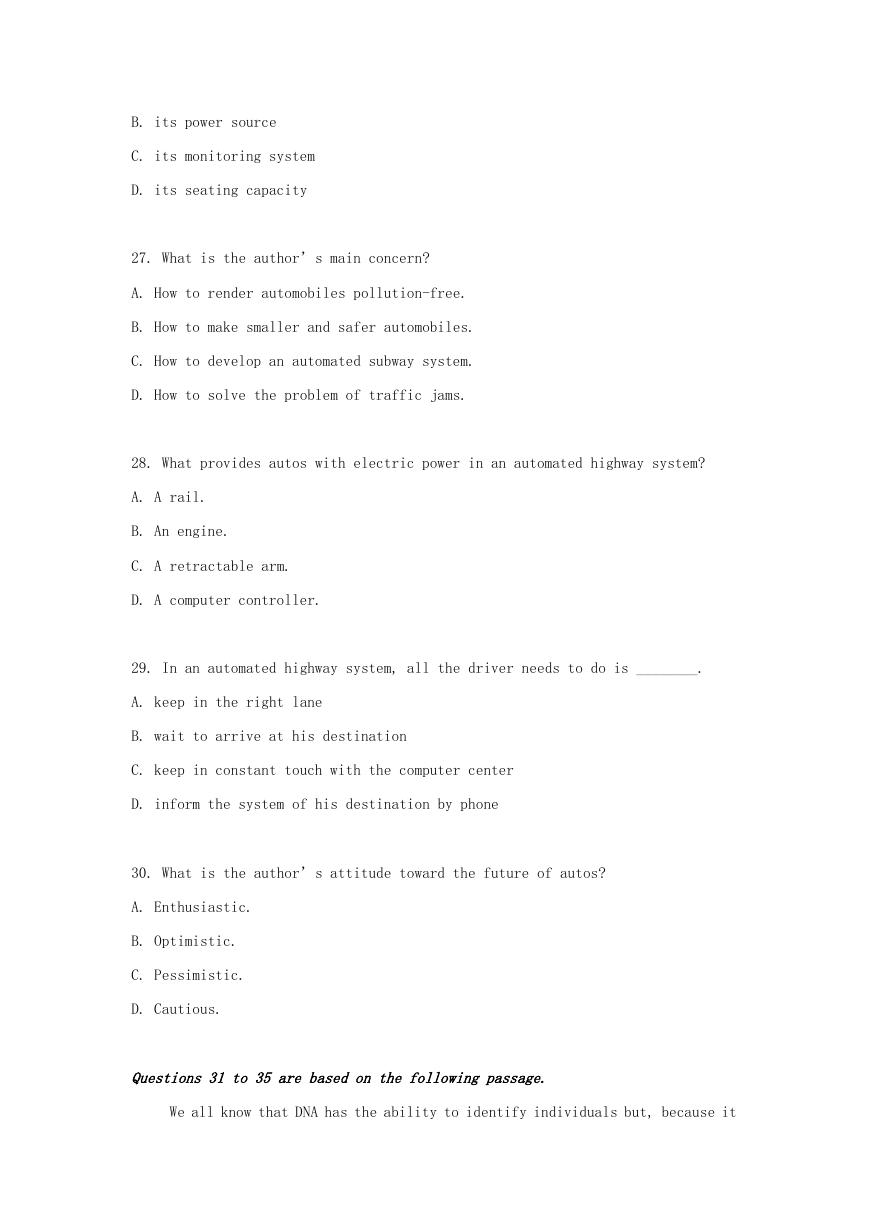

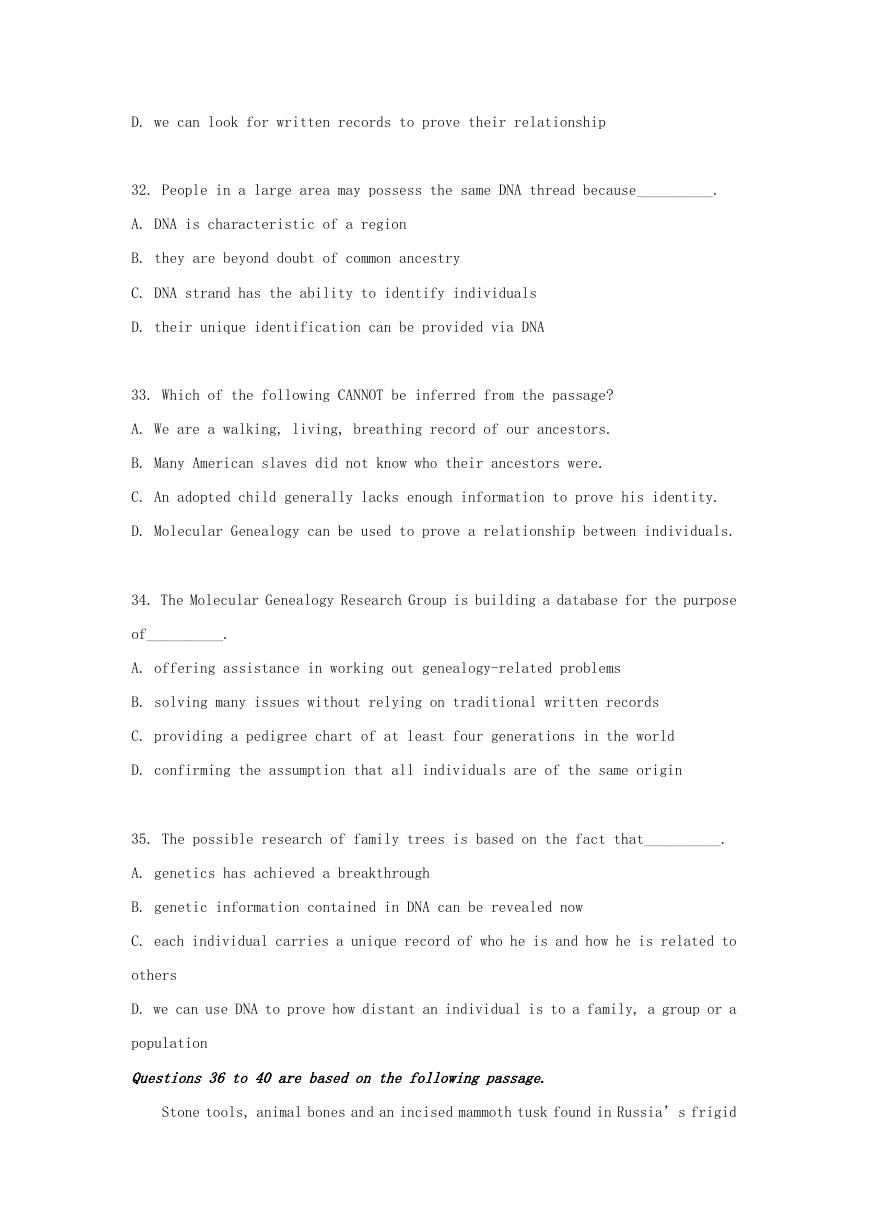








 2023年江西萍乡中考道德与法治真题及答案.doc
2023年江西萍乡中考道德与法治真题及答案.doc 2012年重庆南川中考生物真题及答案.doc
2012年重庆南川中考生物真题及答案.doc 2013年江西师范大学地理学综合及文艺理论基础考研真题.doc
2013年江西师范大学地理学综合及文艺理论基础考研真题.doc 2020年四川甘孜小升初语文真题及答案I卷.doc
2020年四川甘孜小升初语文真题及答案I卷.doc 2020年注册岩土工程师专业基础考试真题及答案.doc
2020年注册岩土工程师专业基础考试真题及答案.doc 2023-2024学年福建省厦门市九年级上学期数学月考试题及答案.doc
2023-2024学年福建省厦门市九年级上学期数学月考试题及答案.doc 2021-2022学年辽宁省沈阳市大东区九年级上学期语文期末试题及答案.doc
2021-2022学年辽宁省沈阳市大东区九年级上学期语文期末试题及答案.doc 2022-2023学年北京东城区初三第一学期物理期末试卷及答案.doc
2022-2023学年北京东城区初三第一学期物理期末试卷及答案.doc 2018上半年江西教师资格初中地理学科知识与教学能力真题及答案.doc
2018上半年江西教师资格初中地理学科知识与教学能力真题及答案.doc 2012年河北国家公务员申论考试真题及答案-省级.doc
2012年河北国家公务员申论考试真题及答案-省级.doc 2020-2021学年江苏省扬州市江都区邵樊片九年级上学期数学第一次质量检测试题及答案.doc
2020-2021学年江苏省扬州市江都区邵樊片九年级上学期数学第一次质量检测试题及答案.doc 2022下半年黑龙江教师资格证中学综合素质真题及答案.doc
2022下半年黑龙江教师资格证中学综合素质真题及答案.doc